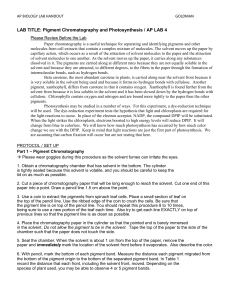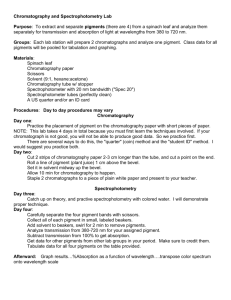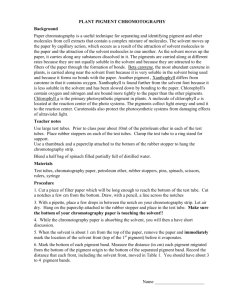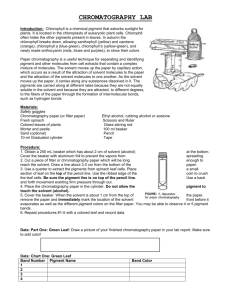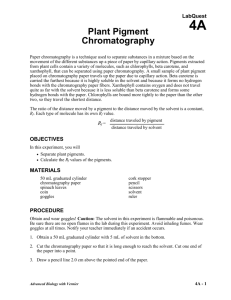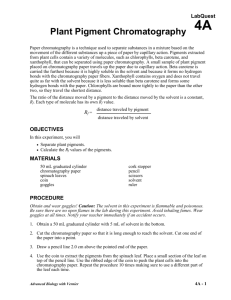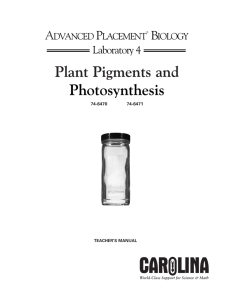LAB TITLE: Pigment Chromatography and
advertisement
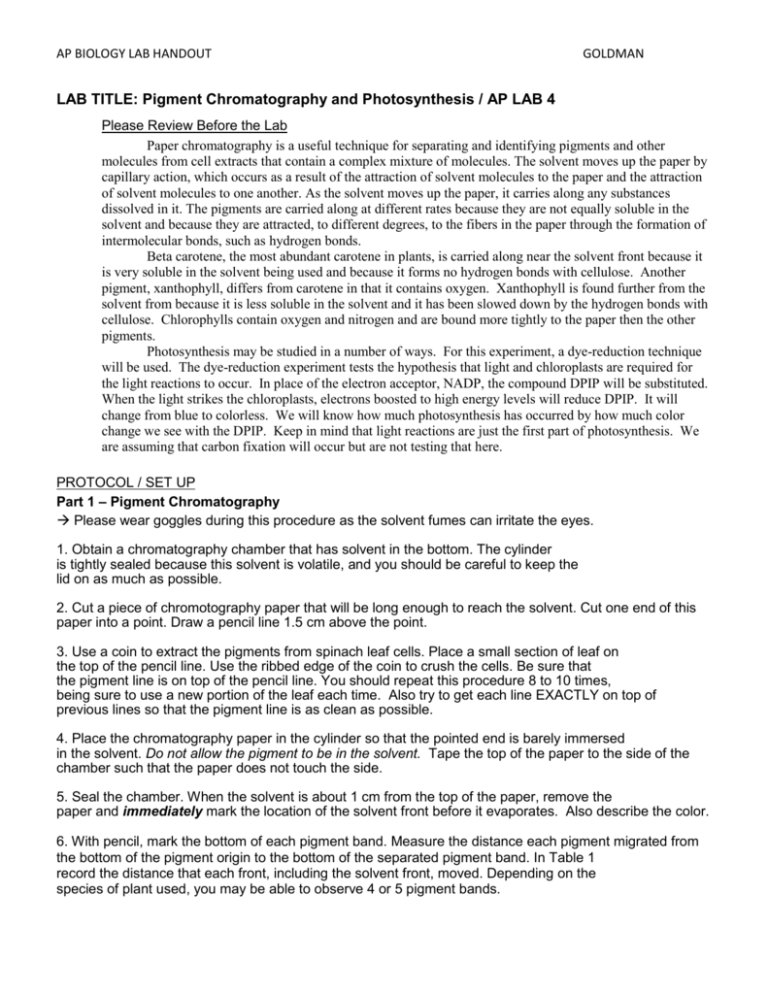
AP BIOLOGY LAB HANDOUT GOLDMAN LAB TITLE: Pigment Chromatography and Photosynthesis / AP LAB 4 Please Review Before the Lab Paper chromatography is a useful technique for separating and identifying pigments and other molecules from cell extracts that contain a complex mixture of molecules. The solvent moves up the paper by capillary action, which occurs as a result of the attraction of solvent molecules to the paper and the attraction of solvent molecules to one another. As the solvent moves up the paper, it carries along any substances dissolved in it. The pigments are carried along at different rates because they are not equally soluble in the solvent and because they are attracted, to different degrees, to the fibers in the paper through the formation of intermolecular bonds, such as hydrogen bonds. Beta carotene, the most abundant carotene in plants, is carried along near the solvent front because it is very soluble in the solvent being used and because it forms no hydrogen bonds with cellulose. Another pigment, xanthophyll, differs from carotene in that it contains oxygen. Xanthophyll is found further from the solvent from because it is less soluble in the solvent and it has been slowed down by the hydrogen bonds with cellulose. Chlorophylls contain oxygen and nitrogen and are bound more tightly to the paper then the other pigments. Photosynthesis may be studied in a number of ways. For this experiment, a dye-reduction technique will be used. The dye-reduction experiment tests the hypothesis that light and chloroplasts are required for the light reactions to occur. In place of the electron acceptor, NADP, the compound DPIP will be substituted. When the light strikes the chloroplasts, electrons boosted to high energy levels will reduce DPIP. It will change from blue to colorless. We will know how much photosynthesis has occurred by how much color change we see with the DPIP. Keep in mind that light reactions are just the first part of photosynthesis. We are assuming that carbon fixation will occur but are not testing that here. PROTOCOL / SET UP Part 1 – Pigment Chromatography Please wear goggles during this procedure as the solvent fumes can irritate the eyes. 1. Obtain a chromatography chamber that has solvent in the bottom. The cylinder is tightly sealed because this solvent is volatile, and you should be careful to keep the lid on as much as possible. 2. Cut a piece of chromotography paper that will be long enough to reach the solvent. Cut one end of this paper into a point. Draw a pencil line 1.5 cm above the point. 3. Use a coin to extract the pigments from spinach leaf cells. Place a small section of leaf on the top of the pencil line. Use the ribbed edge of the coin to crush the cells. Be sure that the pigment line is on top of the pencil line. You should repeat this procedure 8 to 10 times, being sure to use a new portion of the leaf each time. Also try to get each line EXACTLY on top of previous lines so that the pigment line is as clean as possible. 4. Place the chromatography paper in the cylinder so that the pointed end is barely immersed in the solvent. Do not allow the pigment to be in the solvent. Tape the top of the paper to the side of the chamber such that the paper does not touch the side. 5. Seal the chamber. When the solvent is about 1 cm from the top of the paper, remove the paper and immediately mark the location of the solvent front before it evaporates. Also describe the color. 6. With pencil, mark the bottom of each pigment band. Measure the distance each pigment migrated from the bottom of the pigment origin to the bottom of the separated pigment band. In Table 1 record the distance that each front, including the solvent front, moved. Depending on the species of plant used, you may be able to observe 4 or 5 pigment bands. AP BIOLOGY LAB HANDOUT GOLDMAN Part 2 – Light Reactions Procedure 2a – Preparing Serial Dilution of DPIP 1. Look at serial dilution. Ms G has already prepared 2 sets of these. You will use this to compare your tubes to known colors so that you can determine DPIP concentration in your tubes. Be sure you understand this concept before proceeding. A B C D E F G H I J K Phosphate 1 ml 1 ml 1 ml 1 ml 1 ml 1 ml 1 ml 1 ml 1 ml 1 ml 1 ml Buffer DI Water 3 ml 3.1 ml 3.2 ml 3.3 ml 3.4 ml 3.5 ml 3.6 ml 3.7 ml 3.8 ml 3.9 ml 4 ml DPIP 1 ml 0.9 ml 0.8 ml 0.7 ml 0.6 ml 0.5 ml 0.4 ml 0.3 ml 0.2 ml 0.1 ml 0 ml % DPIP 20% 18% 16% 14% 12% 10% 8% 6% 4% 2% 0% remaining % DPIP 0% 2% 4% 6% 8% 10% 12% 14% 16% 18% 20% reduced Procedure 2b 1. Obtain 5 test tubes or cuvettes. Label them 1-5 using masking tape. Cover tube #2 completely in foil (but you will have to take it out of the foil eventually). Set yourself up somewhere with lots of natural light. If the day is cloudy, we will need to bring in some lamps. 2. Use the table below to prepare the contents of your tubes. Use pipettes to add the appropriate amount of phosphate buffer, DI water, and DPIP to your tubes. DO NOT add chloroplasts yet. 1 2 3 4 5 Blank Dark, Unboiled Light, Unboiled Light, Boiled Light, None Phosphate 1 ml 1ml 1ml 1ml 1ml Buffer DI Water 4 ml 3ml 3ml 3ml 3ml + 3 drops DPIP --1 ml 1 ml 1 ml 1 ml Unboiled 3 drops 3 drops 3 drops ----Chloroplasts Boiled ------3 drops --Chloroplasts 3. Obtain samples of chloroplast suspension. Keep both on ice throughout this experiment. 4. Swirl the chloroplast suspensions to mix thoroughly. When you are ready, add the correct amount of chloroplast to each tube. Remember to only expose tube 2 to light long enough to add your chloroplast. Be sure to add the right chloroplast to the right tube. You won’t get re-dos. 5. Swirl all 5 tubes to mix contents. Compare the color in the tube to the colors of your serial dilution from part 2a. Record %DPIP reduced at time 0. 6. Keeping tubes 1, 3, 4, and 5 in the same light conditions, and keeping tube 2 in the dark. Continue to check and record %DPIP reduced after 5, 10, and 15 minutes. DATA TABLE (Include all data and observations in data tables): Part 1 – Pigment Chromatography Distance Solvent Front Moved _______________(mm) AP BIOLOGY LAB HANDOUT GOLDMAN Table 1 – Pigment distance Pigment 1) Carotene Band Color Yellow / yellow orange 2) Xanthophyll Yellow 3) Chlorophyll a Bright green / blue green 4) Chlorophyll b Yellow green / olive green Distance Traveled(mm) 5) Other Table 2 - %DPIP Reduced Tube # Time 0 1 2 3 4 5 Time 5 min Time 10 min Time 15 min DATA ANALYSIS 1. Calculate Rf values for each pigment visible on the chromatography paper. Rf = distance traveled by the pigment divided by distance traveled by the solvent. 2. Sketch your chromatography paper with solvent and pigment lines. 3. Graph % transmittance of tubes 2-5. Graph all four lines on the same axis. Label each line Calculate average rate of photosynthesis in each tube. Label each line. CONCLUSIONS 1. What factors are involved in the separation of the pigments? 2. Would you expect the Rf value of a pigment to be the same if a different solvent were used? Explain. 3. What is the effect of the darkness on the reduction of DPIP in this experiment? What is the effect of darkness on photosynthetic rate in general? 4. What is the effect of boiling the chloroplast? What can you conclude about the molecular structure of the pigments in the chloroplast from this? 5. In general, what are the optimum conditions for photosynthesis? LAB SUMMARY TABLE Each tube in this experiment held a very specific experimental purpose in terms of running a completely controlled experiment. Explain what the value of each was in this respect.
